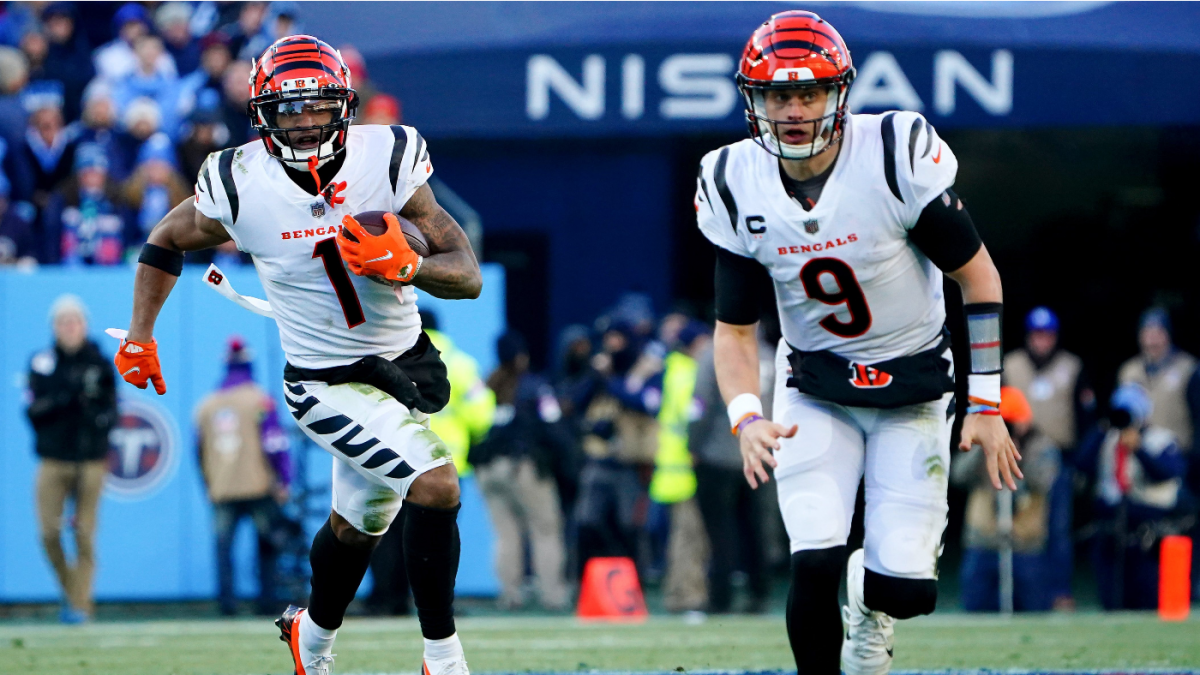How Bengals advanced to AFC title game: Key moves, wins, turning point, biggest reasons for success
Written by ABC AUDIO ALL RIGHTS RESERVED on January 30, 2022

The Cincinnati Bengals have never won a Super Bowl in their 54-year history, but they’re two wins away after upsetting the top-seeded Tennessee Titans and advancing to their first AFC Championship game since 1988. On Sunday afternoon, the Bengals will take on the two-time defending AFC champion Kansas City Chiefs in a battle to represent their conference in the big game.
Before looking forward and breaking down what to expect when these two teams meet Sunday afternoon, it’s worth looking back on how the Bengals got to this point. The story begins in 2019, when Cincinnati moved on from its most successful coach in recent memory (Marvin Lewis, who had restored the team to respectability after 14 consecutive playoff-less seasons) and began to operate just a little bit differently than it had for the early portion of the 21st century.
Cincinnati replaced Lewis with Zac Taylor, who had previously been the quarterbacks coach of the Los Angeles Rams, where he helped Sean McVay turn Jared Goff from a rookie-year laughingstock into one of the league’s most effective quarterbacks in 2017 and 2018. Taylor brought in former Broncos and Raiders quarterbacks coach Brian Callahan as his offensive coordinator, and former Dolphins and Giants defensive backs coach Lou Anarumo as his defensive coordinator.
The first season of the Taylor era was wildly unsuccessful — at least on the field. The Bengals went 2-14, good for the worst record in the NFL. Incumbent quarterback Andy Dalton regressed hard, putting together one of the worst seasons of his career. The offense lagged, finishing 26th in total yards and 29th in yards per play, 30th in both total points and points per drive, and 29th in Football Outsiders’ DVOA. The defense wasn’t much better, checking in 29th in total yards and 31st in yards per play, 25th in total points and 22nd in points per drive, as well as 30th in DVOA.
The good news, though, was that the Bengals secured the No. 1 overall pick in the 2020 NFL Draft, which they used on LSU quarterback Joe Burrow, kicking off a new-and-improved era of Bengals football. Burrow was coming off a magical collegiate season during which he threw for 5,671 yards and 60 touchdowns against only six interceptions. Cincinnati paired Burrow with Clemson wideout Tee Higgins, whom the Bengals drafted at the top of the second round. They added linebacker Logan Wilson in the third round as well.
Interestingly, the Bengals also broke with recent tradition and ventured into free agency, handing out big-money, multiyear deals to multiple players from other teams. They netted defensive lineman D.J. Reader on a four-year, $53 million deal, cornerback Trae Waynes for $42 million over three years, and safety Vonn Bell for three years and $18 million.
The Bengals showed only moderate improvement during the 2020 season, but it at least seemed fairly clear that they had the answer at quarterback. In the season’s first nine games,. Burrow completed 242 of 370 passes (65.4%) for 2,485 yards (6.7 per attempt), 12 touchdowns, and just five interceptions. He added 130 yards and three more scores on the ground. Early in the third quarter of the team’s Week 10 game, though, Burrow (22 of 34 for 203 yards and a score to that point) dropped back to pass from inside his team’s own 10-yard line. The offensive line did not hold up, with each of the tackles allowing perimeter pressure and the interior line collapsing back into Burrow’s face. He got the throw off and gave Tyler Boyd a chance at a jump ball down the field, but he also got high-lowed by Washington’s defense line on the release, and it resulted in Burrow tearing his ACL and MCL, and damaging his PCL and meniscus.
Burrow had already been sacked 32 times to that point in the season, highlighting the weakness of the team’s offensive line. Now, that offensive line had collapsed in the worst way, resulting in a season-ending injury to the team’s franchise passer. With Brandon Allen and Ryan Finley filling in down the stretch, the Bengals limped their way to a 4-12-1 overall record, bad enough to secure the No. 5 overall pick in the 2021 NFL Draft.
All offseason, a debate raged about how the Bengals should handle the selection. Should they draft Oregon tackle Penei Sewell and plug him in as Burrow’s blind-side tackle for the next decade? Or should they take Burrow’s former LSU teammate, wide receiver Ja’Marr Chase, and fix the offensive line a different way? We know which route the Bengals chose. They drafted Chase, and despite his preseason issues with the dropsies, he went on to have an All-Pro season, catching 81 passes for 1,455 yards and 13 touchdowns.
Cincinnati also added two interior offensive linemen (Jackson Carman and Trey Hill, rotational defensive lineman Cameron Sample, and kicker Evan McPherson later in the draft. And again, the Bengals went out and added key pieces in free agency: they signed Trey Hendrickson away from the Saints with a four-year, $60 million, Mike Hilton from the division-rival Steelers on a four-year, $24 million pact, Chidobe Awuzie from the Cowboys on a three-year $21.75 million deal, added Riley Reiff, Eli Apple, and Larry Ogunjobi on value contracts, and traded for B.J. Hill.
Hendrickson followed up his breakout 2020 campaign with an even better season in 2021, notching 14 sacks and finishing among the league leaders in pressures. Hilton maintained his strong play in the slot. Awuzie had the best season of his career playing in Anarumo’s defense. Reiff played well on the right side of the offensive line, Apple emerged as a consistent starter, and Ogunjobi and Hill played well next to Reader on the defensive interior. Holdovers from the previous regime like Jessie Bates III and Sam Hubbard blossomed into excellent players, while players from the Taylor era’s first drive — most notably Jonah Williams and Germaine Pratt — became key pieces on each side of the ball.
So, even though the Bengals’ offense started a bit slowly as Burrow worked his way back into shape and the team eased into the year with a run-oriented approach, by the time they came back from their bye week, they were ready to fire on all cylinders. And they did just that, winning five of their first seven games after the break, including three straight against the Broncos, Ravens, and Chiefs. They wrapped up the AFC North before Week 18 even began, and were able to rest key players to get ready for the playoffs.
The Bengals hosted the Raiders in the wild card round, the team’s first playoff game since 2015. It was the Chase show pretty much all afternoon. The star rookie finished with nine catches for 116 yards, and Cincinnati captured its first playoff victory since 1990. They had to go on the road to play the No. 1 seed Tennessee Titans last week, and thanks to McPherson’s 52-yard field goal as time expired, the Bengals are set to play in the AFC title game for the first time since 1988.
They overcame a monster defensive performance to do it, as Burrow was sacked a playoff-record-tying nine times by Titans defenders. Cincinnati’s defense came through with its own dominant performance, intercepting three Ryan Tannehill passes and holding Derrick Henry to just 62 yards on his 20 carries.
Next comes perhaps the toughest test of all, as the Bengals have to travel to Kansas City, where they’ll take on Patrick Mahomes and the Chiefs. Kansas City has hosted each of the last three AFC title games, advancing to the Super Bowl in each of the last two years. In just less than a week, we’ll find out if the Bengals can go on the road and pull off an upset. If they can do that, they’ll be just one win away from capturing the first Super Bowl title in franchise history.
Bengals results
Week 1: Bengals 27, Vikings 24, OT (1-0)
Week 2: Bears 20, Bengals 17 (1-1)
Week 3: Bengals 24, Steelers 10 (2-1)
Week 4: Bengals 24, Jaguars 21 (3-1)
Week 5: Packers 25, Bengals 22, OT (3-2)
Week 6: Bengals 34, Lions 11 (4-2)
Week 7: Bengals 41, Ravens 17 (5-2)
Week 8: Jets 34, Bengals 31 (5-3)
Week 9: Browns 41, Bengals 16 (5-4)
Week 10: BYE
Week 11: Bengals 32, Raiders 13 (6-4)
Week 12: Bengals 41, Steelers 10 (7-4)
Week 13: Chargers 41, Bengals 22 (7-5)
Week 14: 49ers 26, Bengals 23, OT (7-6)
Week 15: Bengals 15, Broncos 10 (8-6)
Week 16: Bengals 41, Ravens 21 (9-6)
Week 17: Bengals 34, Chiefs 31 (10-6)
Week 18: Browns 21, Bengals 16 (10-7)
Wild Card: Bengals 26, Raiders 19 (11-7)
Divisional: Bengals 19, Titans 16 (12-7)
Conference: Bengals at Chiefs
The post How Bengals advanced to AFC title game: Key moves, wins, turning point, biggest reasons for success first appeared on CBS Sports.



